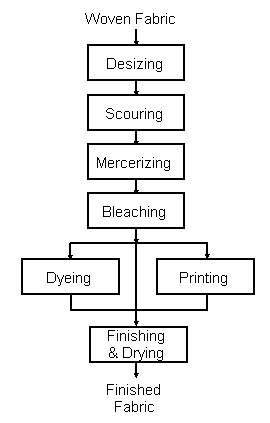This category of operating unit, used to finish woven greige fabric, is one of the most important because of the significant effluent load generated from the removal of foreign matter during cleaning and from various chemicals used in finishing. This category may be divided into two groups. The first removes impurities, cleans or modifies the cloth (desizing, scouring, bleaching, mercerizing). The second group involves dyeing, printing, resin treatment, water or flame proofing, soil repellency and a few special finishes. These all generate various effluents, mostly those chemicals and additives washed off in the processing. This category also includes integrated woven fabric finishing mills, although the greige goods section contributes only a small amount of the overall effluent load from an integrated mill.
Certain fabrics, including denims and some drapery goods, are loom finished. To make these goods, the warp yarns are dyed, woven into a fabric, and then fabric-finished with a permanent size. For these fabrics the first group of processes listed above (i.e.cleaning and preparing the cloth) is avoided entirely. The degree of finishing necessary to provide fabric ready for sale depends significantly on the fibre(s) being processed. The natural fibres (cotton and wool) contain substantial impurities, even after they have been woven as greige goods, and require special treatment to convert them to the completely white, uniformly absorbent form essential for dyeing, resin treatment, etc. Synthetic fibres contain only those impurities that were necessary for manufacture of the fibre and spinning to obtain the yarn. A flow sheet of woven fabric finishing is given in Figure 5 [10].
